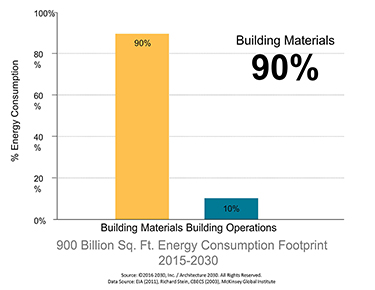|
Subscribe / Renew |
|
|
Contact Us |
|
| ► Subscribe to our Free Weekly Newsletter | |
| home | Welcome, sign in or click here to subscribe. | login |
Environment
| |
 |
March 24, 2016
What is embodied carbon and why should we care?
Skanska USA

Smedley
|
During last month’s BuildWell conference in San Francisco, I dined with the leading thinkers, researchers, engineers and designers tackling the issue of carbon in the built environment. We had a lively and serious conversation.
We talked first about what getting to zero carbon in the built environment truly entails. It became clear that there has been a keen focus on reducing carbon emissions in our buildings through increased energy efficiency, leading to less operational carbon over the course of a building’s life.
There are benchmarks in place, like those defined by the 2030 Challenge, to help us understand where to start and what to track, and certification systems that allow us to feel the accolades of achieving these operational efficiencies.
Technologies are being developed to help us get to closer to net-zero energy. We can now say “net-zero energy” and get nods and affirmations instead of raised eyebrows, which I personally experienced only a handful of years ago.
Embodied energy and embodied carbon emissions are a different story. It’s one that is still in its Wild West phase, with people shooting from the hip in terms of what to assess and how to assess it, and creating their own company- and market-sector-specific benchmarks, sometimes based on arbitrary choices of data source and tracking methodology.
Defining embodied carbon
Perhaps I should step back and make sure we all understand what embodied carbon truly is: Embodied carbon includes the carbon dioxide emitted from the extraction of raw materials through the final manufacture of a product.
A building’s embodied carbon encompasses the embodied carbon of all its materials, as well as carbon emissions from transportation of those materials to the building site.
In Skanska’s efforts to track and understand our buildings’ embodied carbon, we also aim to include emissions from construction activity such as equipment use, transportation of workers to and from the jobsite, and land disturbance in construction.
Where things stand
While we are currently capable of benchmarking operational energy consumption, employing sustainable strategies in design and tracking savings during operation, we do not have a benchmark for embodied carbon.
We don’t have standard practices and resources for incorporating embodied carbon reduction strategies into our design process, and we aren’t aligned on what should and shouldn’t be included in embodied carbon calculations when it comes to building construction.
Because we are in the business of constructing buildings, Skanska understands the role materials procurement and construction practices play in a building’s holistic carbon story.
In Seattle, Boston, Houston and Washington, D.C. — markets where Skanska is the owner/developer/builder — we have developed our own construction tool and format for tracking the embodied carbon of our commercial development projects. This has helped us understand what our averages are, set our own benchmarks, and work to reduce embodied carbon emissions in our buildings based on what we are learning.
A few others in the design, construction and research sectors are also committed to this — each of us using our own methods and resources to try to determine what are the materials and construction heavy hitters.
The good news is that when we compare our embodied carbon calculations to the work done by others, the results are similar. Independent organizations are coming to the same conclusions about the highest-impact materials and processes, helping determine where we should initially focus our efforts when targeting significant embodied carbon reductions in our buildings.
Next steps
There comes a point when actions speak louder than words or data.
We are at that point with embodied carbon — there is enough data to arrive at reasonable conclusions, and enough of a critical mass acknowledging the timely need for embodied carbon reductions in buildings. The next step is to set reasonable benchmarks and get to work.
Setting benchmarks for average embodied carbon, as found in a series of standard building types, would create a line in the sand for owners, designers and contractors to reference when looking at where and how to make impactful reductions.
Benchmarks would allow the development of design tools that enable project teams to assess the embodied carbon reduction impact of various site, material and construction operation decisions. This assessment would create a pathway to proactively measure and document progress toward zero carbon, and a platform for builders to tell a meaningful carbon reduction story.
Studies show that over the next 20 years, 900 billion square feet of new and rebuilt buildings will be constructed in cities worldwide. That equates to building an entire New York City every 47 days.
The counterbalance to this is the outcome of last year’s Paris climate conference, where over 200 countries acknowledged that we must keep global temperature increase under 1.5 degrees Celsius or face dire climate-change consequences. To ensure our best chance of staying below this mark, we must create embodied carbon benchmarks and commit to reductions that lead to zero carbon emissions by 2050, and we must do it quickly.
The time to align around a comprehensive path to zero embodied carbon is now, and Skanska is committed to being a part of the necessary action.
Stacy Smedley is the director of sustainability at Skanska USA, where she provides strategic guidance across Skanska projects in the Seattle area and nationwide.
Other Stories:
- Big-box store gets a second life after a green makeover
- ‘Passive house’ design can make housing more affordable
- Weyerhaeuser’s new headquarters will show off its wood products
- Developers who try to go green find money stands in their way
- Building operators add energy management to their repertoire
- Ballard fire station goes from energy hog to energy heaven
- South Lake Union’s ‘swale on Yale' is getting set to grow
- How sharing sit-stand desks will help Antioch be smaller and greener




